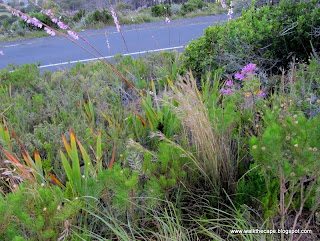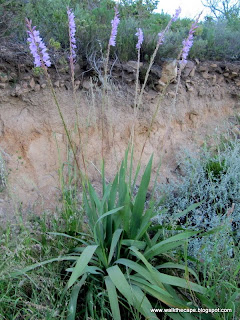 Date:
Date: 24 October 2009
Location: Camps Bay
Walkers: Delphi, Michele & Helen
****
Route plotted here ****
We met on Theresa Ave early in the morning and set off for our walk, following exactly
the same route along the pipe track that we'd taken the previous weekend.This time, however, we were heading on to Corridor Ravine, and up.

Beside the jeep track we spotted several Aristea capitata flower spikes, the buds just starting to open up. They're going to be spectacular soon.

The weather was rather dramatic. Mist was drifting around the peaks above.

Lion's Head and Camps Bay were ribboned with early-morning cloud.

We weren't too concerned about the clouds. The forecast for the day was good, and it was a lovely calm morning. We knew that the sun would burn the mist away later in the day. In the meantime we were enjoying the cool - in fact, it was perfect walking weather.

It wasn't long until we got to Slangolie Ravine.




Here we saw this rather ambiguous graffiti. I wonder what it means?

On the way to the waterfall we noticed a narrow cave entrance. Very dark inside! We found it interesting that there was considerably less water around than the week before. We hardly got wet crossing underneath the waterfall, while last time we got soaked.


Going up Slangolie is not recommended as it is very rocky and dangerous. In fact, it looked like new rockfalls had occurred here fairly recently.


We followed the path to the opposite side of the ravine. It climbs steadily through beautiful forest. There were lots of birds twittering in the trees.




The path pops up out of the forest at the base of the cliff-face.


Rocky overhangs and big boulders - will have to come back and explore!


Great views down to the Atlantic below, and back to Lion's Head. And at last, the sun was out.


Alongside this path was growing a Lessertia frutescens. This plant was previously known as Sutherlandia.



The path around the front of Slangolie Buttress was very pleasant. It was lush and green, with lots of fragrant confetti bush.




We could see down to peaks beyond, with Corridor Buttress directly ahead.


Here, we took a turn to the left, up Corridor Ravine. This is one of the easiest routes up to the top of the mountain. It isn't a deep ravine at all, but a shallow open valley between Corridor Buttress and Verreaux Crag. Although the ascent isn't hard, the path itself isn't in very good shape (lots of loose stones and slippery sections) so we climbed slowly and carefully. A steady slog up to the top!




Mists were blowing up gently from the sea below and swirling around the peaks, making for great atmosphere.

Growing on the lower slopes of the ravine were many blue Moraea tripetala. I find their willowy shape enchanting.






In the middle section of the ravine were fields of yellow Bulbine alooides.






We also spotted some white pompom flowers. I think the one on the left might be a white Scabiosa columbaria. I'm not sure about the one on the right, but maybe an Agathosma of some sort?


And growing amongst the rocks, Struthiola striata.


As we climbed the mist cleared a bit and we could see all the way down to the ocean below. What a view!

At last, we were up! It was very rocky at the top of the ravine.




Constantia Corner and the Back Table were visible across the way.

We now joined the path that runs along the spine of the Twelve Apostle mountains. We could see it meandering off to our right, in a southerly direction.

We turned left, heading north towards Table Mountain. The mist was back.

We were now on our way to Tranquillity Cracks. The path to this spot is on the left at the first sighting of the cableway upper station. Because of the mist, however, we couldn't see that far ahead, so we took a likely-looking path after more-or-less the right sort of distance from the top of Corridor Ravine. It seemed to be heading in the right direction.

The path was not very distinct but took us through some beautiful fynbos.


It didn't take us to the usual 'opening' to the cracks, but instead led us to the front of this rock formation. We ended up clambering over rocks and past trees to get in.

It was quite a lot of fun!






We hopped down into the cracks.

These cracks are a series of interlinking deep and narrow corridors between the rocks. There is a whole network of them. This strange rocky environment is not visible at all from the outside. It is such a surprising hidden wonderland. We spent some time exploring.




On a hot day it's lovely and cool down here. Yes, tranquil :-)



Yellowwoods and other trees thrive in this sheltered environment.






Tranquillity Cracks is a great place to have a picnic. We were lucky to have the place to ourselves.

After our break we left the cracks from the front entrance and found the path back to the spine route. This was a more direct path than the one we'd taken earlier to get to the cracks, although it was also rather overgrown. But it didn't take long to get to the main path.

Some of the fynbos seen in this vicinity: Drosera trinervia, Diosma hirsuta, Agathosma (lanceolata perhaps?) and lots of pink Erica.




And plenty of felty and furry leaves. Fynbos is very nice to touch.




This white flower caught my eye. I'm not sure what it is.

It should be easy to identify with its distinctive leaves and seed pod. Any ideas?


Our path took us down the hill to the top of Slangolie Ravine.

The ocean looked very far away.


From here, behind us, we could see all the way to Muizenberg.

We continued along the spine path.

And on to a section of wooden board-walk, over a swampy area.


It was here, amongst the reeds, we found beautiful Bulbinella nutans.


We were now close to Kasteelpoort, our descent point. We detoured to the view site. From here we could see our path snaking down the hill.

It was just past midday now and warm, so we took a break near the stream.


The walk down KP is one of the easier descents off the mountain, but it is still a lot of
down. Steps and gabions make it easier, but it still requires much concentration, especially when one is tired. I found it a bit hard-going.




A Psoralea pinnata was growing beside the stream.

And beside the path all the way down was cheerful yellow Ixia dubia and purpley-blue Geissorhiza apera.


Half-way down there is big flat rock, a perfect spot to stop to admire the vista. We could see the pipe track and Theresa Ave far below.

From here things got easier. The path cut diagonally across the slope, taking us all the way down. What a wonderful long walk!


Seen growing along the way on this final section: Watsonia borbonica, Erica abietina, Leonotis leonurus and Pseudoselago spuria.




And also this lovely purple Moraea.
 (Photos by Michele and Helen)
(Photos by Michele and Helen)
 Date: 29 October 2009
Date: 29 October 2009























































































































































